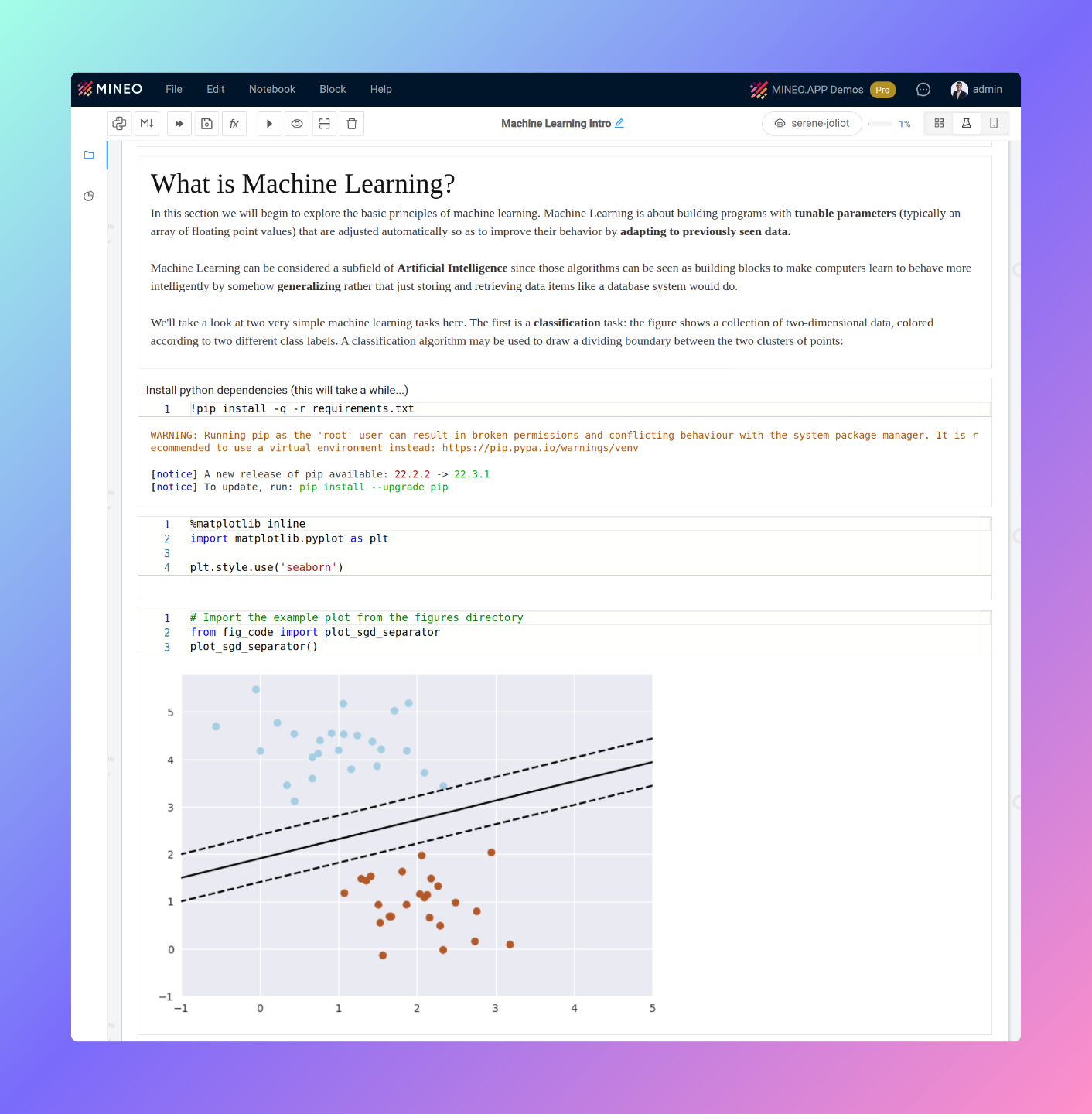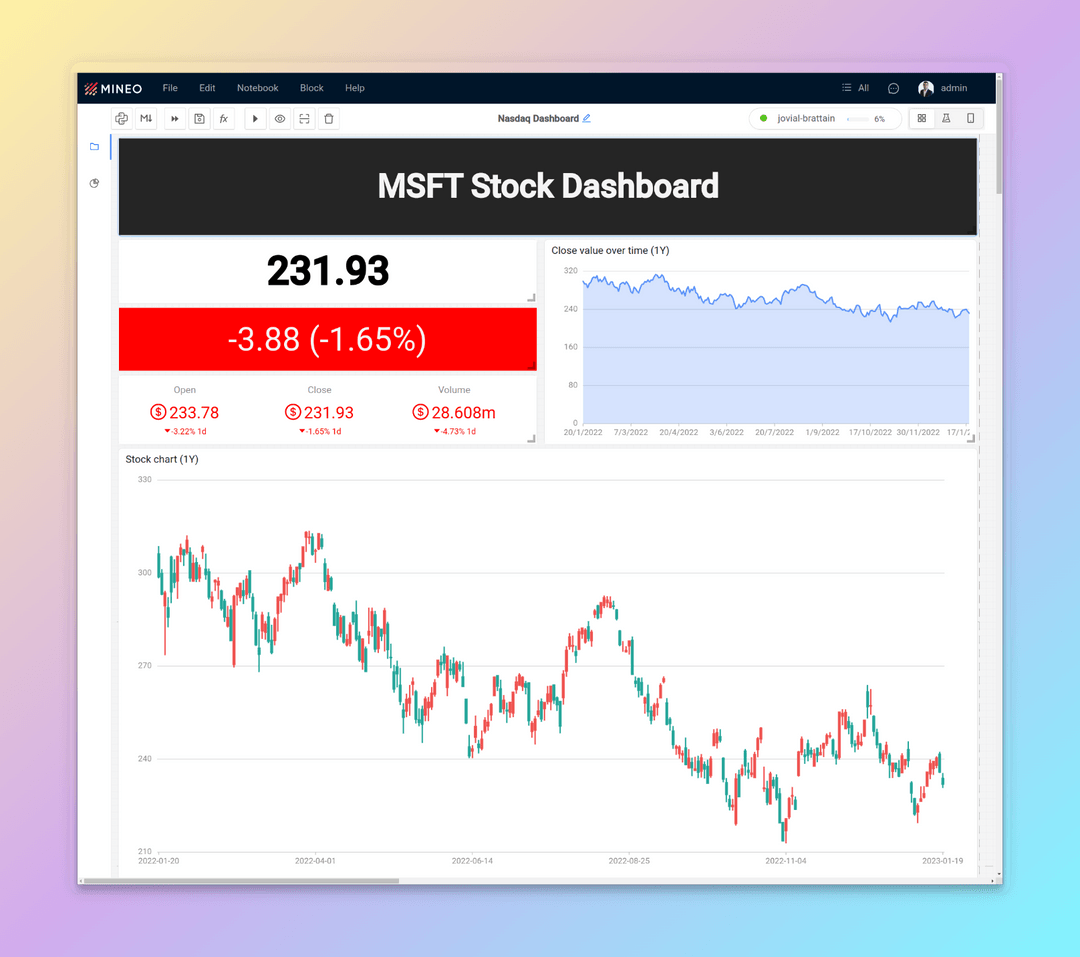
Python notebooks are by far the most common format for implementing data science analysis. In this article, we look at 7 common use cases for Python notebooks beyond data science, including practical examples and the most common tools used in each case.
Data analysis
Data analysis is one of the most popular use cases for Python notebooks, where notebooks are used to explore and analyse large data sets. Python notebooks provide a flexible and interactive environment for exploring, visualising and cleaning data. Analysts can use Python notebooks to perform data wrangling, filter and subset data, and transform data into different formats.
The most commonly used data analysis tools in Python notebooks are Pandas, Numpy and Matplotlib libraries.
- Pandas provides data structures and functions for manipulating and analysing large data sets.
- Numpy is a powerful array processing library that can perform complex mathematical operations on arrays of data.
- Matplotlib provides tools for creating visualisations, including plots, graphs and histograms.
Data analysis in Python notebooks can be used for a wide range of applications, including finance, healthcare, social media and e-commerce. Some examples of data analysis in Python notebooks include analysing customer behaviour and preferences, detecting fraud in financial transactions, and identifying trends and patterns in social media data. The interactive and exploratory nature of Python notebooks makes them a valuable tool for any data analysis project.
Machine learning
Machine learning is another popular use case for Python notebooks, where the notebooks are used to develop and train machine learning models. Python notebooks provide a convenient way to write, test and visualise machine learning code. With machine learning, analysts can train models on large data sets and use those models to make predictions or identify patterns in new data.

The most commonly used machine learning tools in Python notebooks are Scikit-learn, TensorFlow, and Keras.
- Scikit-learn provides a wide range of machine learning algorithms for classification, regression and clustering, as well as tools for model selection and evaluation.
- TensorFlow is a powerful open source machine learning library, specifically for deep learning, that can be used to build neural networks and other advanced models.
- Keras is a high-level neural network API built on top of TensorFlow, making it easier to build and train deep learning models.
Machine learning in Python notebooks can be used for many applications, such as fraud detection, image recognition and natural language processing. For example, machine learning models can be trained to detect fraudulent transactions in real time, or to automatically recognise objects in images or videos.
Python notebooks make it easy to experiment with different algorithms and hyperparameters, and to visualise the results of machine learning models. The flexibility and interactivity of Python notebooks make them an ideal tool for machine learning research and development.
Dashboards
Dashboarding is an increasingly popular use case for Python notebooks, where notebooks are used to create data-driven dashboards. Python notebooks provide a convenient environment for building, testing and deploying interactive dashboards that can be used to monitor key performance indicators (KPIs) and make data-driven decisions.
Due to the sequential nature of traditional Python, it’s not possible to create a dashboard in a notebook in platforms such as Jupyter, but in modern platforms such as Mineo it’s very easy to do, thanks to a combination of the dashboard layout mode and widgets that allow interactive dashboards to be easily created.
Another python tool to create small dashboards is streamlit. This service allows you to create simple data apps just writing a few lines of code.
Dashboard creation in Python notebooks can be used for many applications, including business intelligence, real-time monitoring and project management. For example, Python notebooks can be used to create a dashboard that displays KPIs such as sales, customer satisfaction and website traffic.
The interactive nature of Python notebooks makes it easy to experiment with different dashboard designs and layouts, and to quickly iterate on code to test different configurations. Overall, creating dashboards with Python notebooks is a powerful tool for monitoring and analysing data in real time.

Financial dashboard built from a Python notebook
Data visualisation
Data visualisation is a popular use case for Python notebooks, where notebooks are used to create interactive visualisations to help understand complex data sets. Python notebooks provide a convenient environment for data visualisation, with tools that allow users to create charts, graphs, and maps that can be explored and interacted with.
The most commonly used data visualisation tools in Python notebooks are Matplotlib, Bokeh and Seaborn.
- Matplotlib is a powerful data visualisation library that provides a range of plot types and customisation options.
- Bokeh is a data visualisation library that allows users to create interactive visualisations powered by JavaScript.
- Seaborn is a library that provides advanced statistical visualisation tools that allow users to visualise complex statistical relationships in their data.
Data visualisation in Python notebooks can be used for many applications, including business intelligence, scientific research and data journalism. For example, Python notebooks can be used to create dashboards that display key business metrics, or to visualise geographic data to identify patterns or trends. The interactive nature of Python notebooks makes it easy to explore data and create visualisations that can be used to communicate insights to others. Overall, data visualisation with Python notebooks is a powerful tool for understanding and communicating complex data.
Data pipelines
Data pipelines are another popular use case for Python notebooks, where notebooks are used to create end-to-end data processing workflows. Python notebooks provide a flexible and interactive environment for building, testing and deploying data pipelines that can move data from one system to another and transform it along the way.
- Dask: Dask is a Python library for parallel computing that can be used for building data pipelines. It provides a high-level interface for distributed computing and allows you to scale data processing tasks across multiple cores or nodes. Dask supports various data structures, such as Pandas dataframes and NumPy arrays, making it easy to integrate with existing data pipelines.
- PySpark: PySpark is a Python library for Apache Spark, a distributed computing platform for processing large data sets. PySpark provides a high-level API for building data pipelines that scale to large datasets. It supports multiple data sources, including Hadoop Distributed File System (HDFS), Apache Cassandra, and Amazon S3. PySpark also provides a variety of data processing functions such as filtering, grouping and aggregation.
- Bonobo: Bonobo is a lightweight Python library for building data pipelines. It provides a simple and flexible API for defining ETL workflows. Bonobo allows you to define reusable components and assemble them into complex pipelines. Bonobo can read and write data from a variety of sources including CSV files, databases and APIs. Bonobo can also be integrated with other Python libraries such as Pandas and PySpark.
Data pipelines in Python notebooks can be used for many applications, including ETL (extract, transform, load) operations, real-time data processing, and data warehousing. For example, Python notebooks can be used to extract data from different sources, transform it into a suitable format and load it into a data warehouse for analysis. The interactive nature of Python notebooks makes it easy to experiment with different data processing and transformation techniques, and to quickly iterate on code to test different configurations. Overall, data pipelines with Python notebooks are a powerful tool for managing complex data processing workflows.
Python prototyping
Python prototyping is another popular use case for Python notebooks, where the notebooks are used to create prototypes of software applications or try small snippets of code. Python notebooks provide a convenient environment for rapidly developing and testing software prototypes, allowing developers to quickly iterate on ideas and test different configurations.
Python prototyping in Python notebooks can be used for many applications, including web applications, desktop applications, and mobile applications. For example, Python notebooks can be used to prototype and test the functionality of a web application, including user interfaces, data processing, and database management. The interactive nature of Python notebooks makes it easy to experiment with different frameworks and libraries, and to quickly iterate on code to test different configurations. Overall, Python prototyping with Python notebooks is a powerful tool for rapidly developing and testing software prototypes.
Education
Python notebooks are widely used in education to teach programming and data science concepts. You can use them to create interactive textbooks, lecture notes and assignments that allow students to experiment with code and see the results in real time.
Popular libraries for education are:
- SymPy: SymPy is a symbolic mathematics library for Python. It provides support for the symbolic manipulation of mathematical expressions, along with functions for calculus, algebra, and other areas of mathematics. SymPy is often used in mathematics and engineering courses.
- SciPy: SciPy is a library for scientific computing in Python. It provides support for a variety of scientific and engineering applications, including signal and image processing, optimization, interpolation, and integration. SciPy is commonly used in courses on scientific computing and engineering to teach students how to use Python for numerical analysis and simulation.
Conclusions
Python notebooks have evolved in the last years and are a great tool for a variety of use cases, thanks to a combination of interactive computation and ease of use thanks to the Python language and its libraries.
Happy coding!


